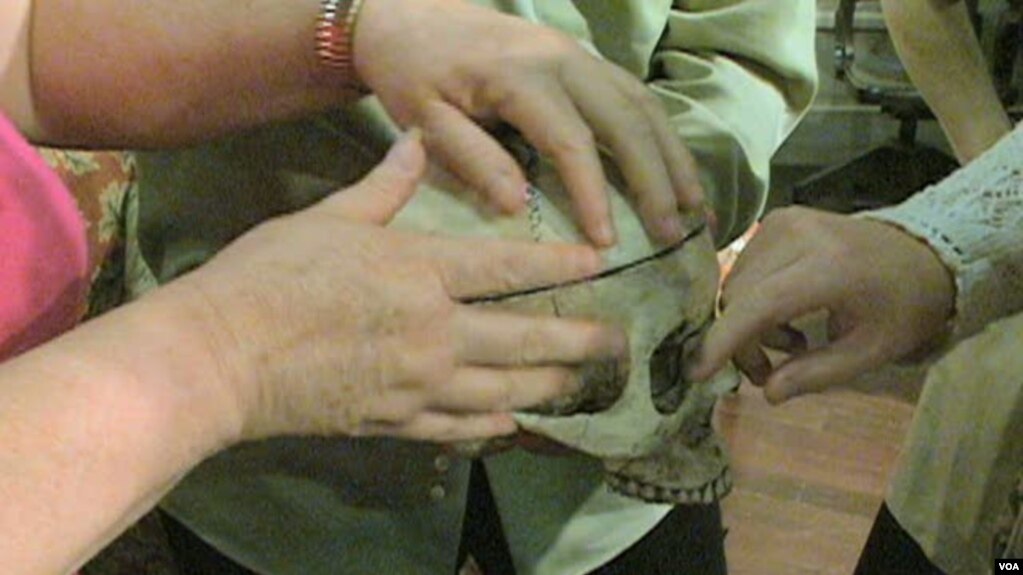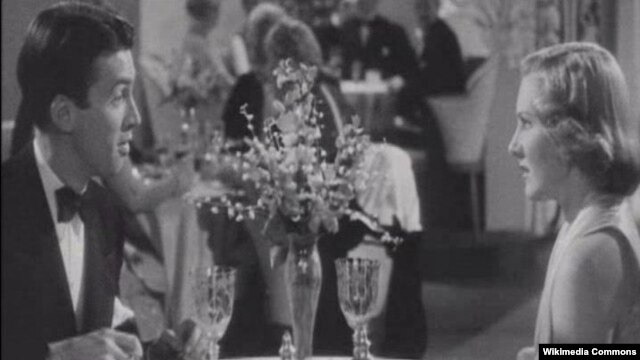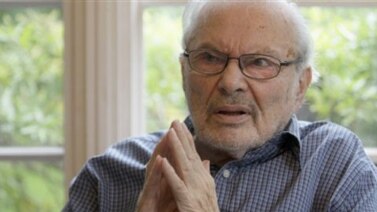
JUNE SIMMS: Welcome to THIS IS AMERICA in VOA Special English. I'm June Simms.
CHRISTOPHER CRUISE: And I'm Christopher Cruise. This week on our program, we visit a theater that has special performances for the blind. Then, we get a lesson in the Suzuki method for teaching young children to play musical instruments. And, later, we look at the growing demand for gluten-free foods in the United States.
(MUSIC)
JUNE SIMMS: "You Can't Take It With You" is a funny play from nineteen thirty-six. But on this day, the people who have come to the Everyman Theatre in Baltimore, Maryland, are not here for a traditional performance. Marcus Kyd is the education director for the theater.
MARCUS KYD: "We are here to take you on an experience through 'You Can't Take It With You.'"
The visitors are all visually impaired. Many theater companies offer wireless earpieces for blind people to hear descriptions of the action on stage. But Everyman Theatre goes a step further. It offers special performances for people with little or no eyesight to experience theater in a different way.
MARCUS KYD: "We don't believe that just because they can't see a play they can't enjoy a play."
CHRISTOPHER CRUISE: The visitors get a chance to go on the stage and touch the things on the set. Not every play includes a touch tour. But Marcus Kyd says "You Can't Take It With You" was a natural choice.
MARCUS KYD: "Almost everything in the play that has to be on stage ends up affecting the story. From the minute you open the script, you know, you get the description of the typewriter, the skull that is holding jellybeans."
Everyman Theatre has been doing touch tours for several years, usually for one play each season.
Roger Williamson regularly attends the theater's touch tours.
ROGER WILLIAMSON: "Because we don't see, we only get to form images of what we think is going on in our mind. So this will enhance the performance greatly, to have a greater imagery of the entire play, not just the voices in what we think the people may look like."
Maurice Peret attended the play before taking the touch tour.
MAURICE PERET: "It brought the play that much more alive knowing what the set looked like. I can recall seeing the play and seeing where some of the performers were sitting. We see more with our brains than with our eyes. So it's not a question of seeing things, but assimilating visual information."
CHRISTOPHER CRUISE: Playwrights George S. Kaufman and Moss Hart wrote “You Can’t Take It With You.” It won a Pulitzer Prize. The play was made into a movie in nineteen thirty-eight, starring Jean Arthur and Jimmy Stewart.

The film was a hit, It won the Academy Award for best picture. And Frank Capra was honored with an Oscar for best director.
Here is some sound from the movie version of “You Can’t Take It With You.”
(SOUND)
JUNE SIMMS: With the Suzuki method, a child first learns to play music by hearing it rather than reading musical notes.
Five-year-old Hannah Mei Steury recently started violin lessons with the Suzuki method. Her teacher, Stephanie Flack, says "Twinkle, Twinkle Little Star" is the first song children learn to play.
STEPHANIE FLACK: "It's a very simple tune that's easy to learn by ear. And then they learn the elements of how to hold the violin, the bow. We put it together slowly and then they're playing music right away."
Hannah Mei's mother, Judy Steury, says she is amazed at her daughter's progress.
JUDY STEURY: "I think it's great, and she does love it, and she's humming it in the car."
Stephanie Flack says she is not surprised. She was a Suzuki student herself as a girl.
STEPHANIE FLACK: "Our method teaches pieces from the beginning."
Her daughter Shannon plays more advanced pieces, and likes classical music.
SHANNON FLACK: "In classical, you can change things up and play it how you want to play it. I usually change the tempos just a tiny bit and the loudness."
CHRISTOPHER CRUISE: Japanese violinist Shinichi Suzuki developed the Suzuki method more than fifty years ago. He believed all children could learn to play music. His method was later was adapted for other instruments. Shinichi Suzuki died in nineteen ninety-eight.
Rhonda Cole became one of the first Suzuki teachers in the United States about forty years ago. She trains violinists to become Suzuki instructors, but says teaching children to play is inspiring.
RHONDA COLE: "They're more sensitive to musical sounds."
JUNE SIMMS: Over time, children learn to read musical notes and later perform complex music. Divya Kumaran remembers how her early training opened a new world for her.
DIVYA KUMARAN: "It feels good after you've completed a song and after it's perfect."
The Suzuki method discourages competition among children. Instead, it encourages them to play together, including public performances.
CHRISTOPHER CRUISE: Kathy Adams joins her son Jared on the piano as he practices each day.
KATHY ADAMS: "I have such an appreciation for what it is to listen, to truly listen to the music. Jared's a great example. He has an amazing violin ear."
Jared says he was excited when he recently got an autograph from Joshua Bell, one of the world's top violinists.
JARED ADAMS: "I think he's absolutely brilliant. This is the first time I've actually walked up to him. I'm not sure if I said hello or not, but it was just amazing."
JUNE SIMMS: Stephanie Flack has been teaching for nine years and says she is still excited to see her students' progress.
STEPHANIE FLACK: "Their love of music and seeing how much they enjoy it is just really is rewarding for me."
(MUSIC)
CHRISTOPHER CRUISE: The smell of freshly baked cookies fills Lucy's bakery in Norfolk, Virginia. They look like the usual sweets you would find in any store, but owner Lucy Gibney says these are special.
LUCY GIBNEY: "Especially special because I don't use typical ingredients."
Lucy Gibney is an emergency room doctor.
LUCY GIBNEY: "Most cookies are made from wheat flour, butter, eggs, and none of those are in our recipes."
Lucy's cookies also do not contain gluten, a protein found in wheat, barley and rye. Some people are sensitive to gluten.
LUCY GIBNEY: "I made cookies with these recipes at home for my son who has food allergies and can't eat gluten, milk or egg, peanuts and tree nuts."
JUNE SIMMS: What began as tasty recipes for her son developed, in four years, into a company with five million dollars in expected sales this year. Many people came to the Lucy's booth at the recent Fancy Food Show in Washington.
MARILYN KLEMM: "I liked what I saw on her website."
Marilyn Klemm owns retail stores in New Hampshire, and is a possible buyer.
MARILYN KLEMM: "I thought I would come and try because my customers are asking more and more for gluten free."
CHRISTOPHER CRUISE: Nearby is Ted Vogelman, from Sticky Fingers Bakeries, a twenty-five-year-old company in the state of Washington. The company offers gluten-free scones.
TED VOGELMAN: "We just started producing gluten free for this show, actually. Basically because of the request of our customers that we carry gluten free."
Show official Louise Krammer says Sticky Fingers and Lucy's were among three hundred companies presenting gluten-free products at the show.
LOUISE KRAMMER: "That is way up. We saw it began a few years ago with maybe twenty to forty companies with gluten-free products. And we are seeing a lot of better products now coming out, not only more but better."
JUNE SIMMS: A market survey shows that sales of gluten-free products topped six billion dollars in two thousand eleven.
Alessio Fasano is the director of the Center for Celiac Research at the University of Maryland. He is not surprised at the growing interest in gluten-free diets.
ALESSIO FASANO: "One of the reasons is that celiac disease, the most known and studied condition that is related to gluten, is much more frequent than we believed before. Besides celiac disease, there is gluten sensitivity that seems to affect many more people, something like six percent of population or eighteen million people."
Alessio Fasano says gluten intolerance, which has a number of symptoms from headaches to infertility, was originally identified in Europeans. But he says it is now seen more often in North Africa, the Middle East and China.
Even people who can tolerate gluten sometimes choose not to eat it.
Vinnie Pamula was a visitor to the food show.
VINNIE PAMULA: "I don't have gluten intolerance, no. But I feel better when I eat gluten-free food sometimes."
(MUSIC)
CHRISTOPHER CRUISE: Our program was produced by Brianna Blake, with reporting by Susan Logue, Deborah Block and June Soh. I'm Christopher Cruise.
JUNE SIMMS: And I'm June Simms. You can read and listen to our programs and find videos for all three of our stories at voaspecialenglish.com. Join us again next week for THIS IS AMERICA in VOA Special English.



